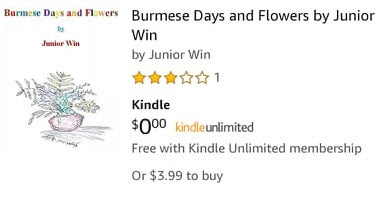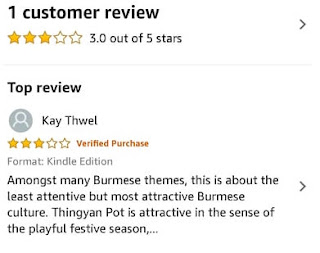
(Burmese Days and Flowers by Junior Win, was on Amazon since 2013 December 29.)
‘Here critics of my book, some I came across. Whatever they write, they have a right to write. So I have a right to copy.
I posted here for my readers who have a right to judge.’
Junior Win
(Updated 2019, April)
1.The first one by Kay Thwel on July 23, 2013.

‘writing about Thingan Pot,’ said Kay Thwel.
Kay Thwel
3.0 out of 5 starsThingyan Pot
July 23, 2013
Format: Kindle EditionVerified Purchase
”Amongst many Burmese themes, this is about the least attentive but most attractive Burmese culture. Thingyan Pot is attractive in the sense of the playful festive season, called Thyingyan, and its charming beauty of seasonal flowers. But making customary Thingyan Pot is not much more attentive as anybody can buy ready-made bunches easily. More so, writing about Thingyan Pot is, I think, the toughest thing, bringing back the history, catching up the glimpse of flowers, and putting all things together. In all aspects, I can see the great effort of the author and the real price of this book.’‘
2.The Second One from Raja Subramanian on November 7, 2015

‘I said that it is more of a reference book, ….’ said Raja Subramanian.
Nov 07, 2015Raja Subramanian rated it really liked it
Shelves: books-owned, read-in-2015
‘‘I have been traveling to Myanmar quite a number of times in the past year. If all goes well, I will be living there for a number of years too, starting end of November 2015. I definitely want to learn as much about Myanmar, its history, culture, traditions etc. My friends in Myanmar have already told me about Thingyan Festival that is celebrated in the month of April. From their descriptions, I understand that it is a colorful festival, with goodwill and playfulness at the core.”
”When I came across Burmese Days and Flowers by Junior Win, I purchased this and read it in one stretch on a flight from Bangkok to Bangalore. This is actually a reference book of sorts that provides a number of details on the Thingyan Pot – a traditional flower pot with colorful seasonal flowers and leaves. I am now better informed about the rich tradition of making a Thingyan Pot (even though one can buy one from the market). The book has so many details and has been extremely well-researched. I said that it is more of a reference book, since I now know that I have to read it several times for all the information to soak in.”
”I think I will be in Mandalay during Thingyan Festival in 2016. This will be a useful book to refer to and learn more. The narration is at times a bit patchy with a few grammatical errors. But it does not take away the passion and the hard work of the author, and her twin brother who chipped in with nice illustrations and photographs. Unfortunately, this is a book I cannot really recommend to any of my friends since it is not of a wider reading interest! I will of course recommend this book to my colleagues who are going to be living in Myanmar for a while!”
3.The Third one was from Bhadda Manika on 13/4/2017,

‘have much appreciation in what you wrote. ‘ said Bhadda Manika.
Bhadda Manika13/4/17 8:12 AM
‘‘One of the Myanmar scholars has posted a text mentioned about the Intangible Heritage of Myanmar on his Facebook page. It is about the spirit of Thingyan, water festival. Among a few photos there is one, “Thingyan Tā O” a pot with flowers and leaves represent the 7-days born. Since am away from Myanmar I was wondering if this tradition is still alive or not. Having googled the relevant topic I come across this blog and have much appreciation in what you wrote. Your sketch of “a-ta-o” is beautiful. Thank you so much. May you be well and happy.”
4.The Fourth One from Amanda Ariela on January 30, 2019

“very poorly written, the English is very broken, with basic mistakes being made, for example, the ‘foreward’ is named ‘forward’, repetitive fashion that really annoys the reader, suggest a strong editor,..” said Amanda Ariela.
Jan 30, 2019Amanda Ariela rated
”Book is interesting and has lots of content and information, but it’s very poorly written.
The English is very broken, with basic mistakes being made in the different chapters (for example, the “foreward” is named “forward) and informations that appear over and over, on a circular and repetitive fashion that really annoys the reader.
I suggest a strong editor and a new way to organize the chapters on a more fluid way of giving away the information.
Nevertheless, an interesting read on the habit of people very different of many. I loved learning more about Burmese New Year and the particularity of the Thingyan pot.”
